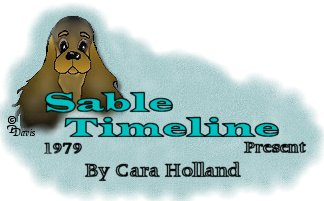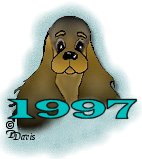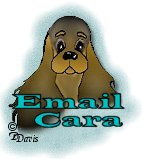
 ASC Board: President-Louise Milner, Deborah Bowman, Marilyn Pryor, Linda Moore, Lillian Roy, Lois Wilson, Kelly Ferris, Harriet Kamps, T. Alan Kloss, Bettie Campbell, Jane Williams, Nancy Gallant, John Zolezzi, Betty McClendon. Standard Chair-Betty Duding.
According to AKC they took this new definition of SABLE from the book "Canine Terminology" by Harold Spira. The definition in that out of print book (text copyright 1982) is as follows: "A colour coat pattern produced by black-tipped hairs overlaid upon a background of silver, gold, grey, fawn, buff, tan or brown basic coat colour in a definite pattern, ranging from the very dark grey sables (syn. Wolfe sable) to the gold or silver sables, with an infinite variety of shades in between, depending on the amount of black-shaded areas involved or depth of colour. The undercoat is usually light and in some breeds and/or individuals there is a black mask. Sable colouring of varying density occurs in many breeds. Typical examples include German Shepard Dog, Belgian Tervuren, Keeshond and Norweigan Elkhound." The type of sable gene expressed in all of these examples is the aw gene also commonly referred to as “wolfe-sable”. This is the fourth allele of the A gene which will produce the agouti or “wild type” of coat color with banded hairs seen in Norwegian Elkhounds, gray German Shepards, Schnauzers and certain wild Canidae. This is NOT the same gene that is expressed by Shetland Sheepdogs, Collies, Pomeranians, and American Cocker Spaniels among others. That gene is the ay gene that produces animals that do not have black-tipped hairs. So if (according to AKC’s NEW definition of sable) only those dogs with black-tipped hairs are “sable”, then what color should those with overlays be called? In books on canine genetics both aw and ay are called SABLE. In most cases the aw gene is called "wolfe-sable". Why the sudden change? I personally contacted AKC and asked why the definition had been changed from what it had been for at least 25 years. I was told that they did not know, that the person who had made those changes was now dead and that it was going to be changed back to the previous definition as they had received MANY complaints from the breeders of various sable colored breeds. The 1997 ballot was the ONLY ballot that was actually voted on as a result of a petition from the membership. An open forum on the Standard was held during the National in July. There was discussion of many aspects of the Standard including the sable colors. The membership was invited to write their thoughts down and send them to the Board. In October of 1997 the Board sent out a compendium* of those letters along with the recommendation from the Standard Committee that the petition should not be voted on at that time. Their reasons included 1) The committee’s opinion that the petition didn’t clearly define sable in the ASCOB or parti varieties. The committee also agreed that sable was not a solid color per AKC’s definition* (which had recently been changed) in the AKC Dog Book, 2) So few sables registered not sufficient to justify a change to the Standard, 3) Six previous votes to include sable or sable/white had never received the required 2/3 majority of ballots returned. (I can only find four previous ballots on sables that didn’t receive the required 2/3 majority of ballots returned-1981, 1983, 1986, and 1990) This compendium was sent out to the membership by virtue of the ASC By Laws Article VII, Section1: "Amendments to the Articles of Inc. and the By Laws, the Code of Ethics and to the Standard for the breed may be proposed by the Board of Directors or by written petition addressed to the Secretary signed by any member in good standing, and co-signed by 20% of the members in good standing. Amendments proposed by such petition shall be promptly considered by the Board of Directors and must be submitted to the entire membership for written comment within 60 days of receipt by publishing in the official ASC newsletter/bulletin or by mail notification." This compendium was composed of letters received FOR (31) and AGAINST (30) the inclusion of the sable colors. Of those letters received AGAINST Carl or Rosalie Anderson wrote 5 of them, Dick or Betty Duding wrote 3 of them and Beth Speich wrote 2 of them. Of those letters received AGAINST, seven (including letters written by Beth Speich and Richard Duding) suggested further study of the gene and its effect on the gene pool. Sounds familiar doesn’t it? This same recommendation was made in 1983 (despite the Standard Committee’s assertion that sufficient evidence had been presented to prove the color had existed in the American Cocker Spaniel) and again in 1984 but had apparently never acted upon. In the same sort of theatrics employed by scandal sheets like the National Enquirer, this compendium also included a rather unflattering picture of a sable. According to the ASC Secretary this picture was provided by Carl Anderson and the use of this picture was unauthorized by the dog’s owner. No pictures of the 30 or so sable/white American Cockers that had completed their championships (despite all the controversy) were printed in the compendium. Another fact worth mentioning here concerns the cost of this petitioned ballot to the ASC: In the 1998 Annual Report Standard Committee Chairman Betty Duding thanks Annette Davies for underwriting part of the cost of the compendium. The membership has also been “warned” over and over again that IF we allow the sable colors to be added to our Standard that AKC will put all Cocker Spaniels into ONE variety with one set of points and one cocker in the Group. When AKC was contacted regarding this "threat", written conformation was as follows: from Mr. David Merriam, (at that time AKC Executive Vice President/CEO) in a letter* "I am not aware of any instance where a change in the breed standard triggered a change in the Group status for that breed." Dr. Al Grossman would seem to verify AKC’s position further when he posted the following to the Champions listserve Oct 30, 2000, "The three varieties of the breed. The reason we have three varieties is cloaked in the mists of the past. As some of you may know, the American Spaniel Club was organized and chartered before the American Kennel Club. In order to have the American Spaniel Club join AKC and to merge it’s stud book, AKC promised (in writing) to allow the ASC to have three varieties. We have, on occasion, sounded out AKC about a fourth variety. The most recent was about the B/T variety. Let me say the response was a deafening NO!" Although I have only been a member of the ASC for about 20 years I had been breeding and showing cockers for about 10 years before I joined and I was paying attention to the activities of the ASC. I do not EVER remember a time when the membership voted to ask AKC for a fourth variety and I assume that would be something that a majority of the membership would have to agree on! So why on earth anyone representing the ASC would ask AKC to allow us a fourth variety for the B/T’s is beyond me! Perhaps this happened back in the late ‘70’s or early ‘80’s when there was so much controversy over WHERE to put the B/T’s? It is my belief that most Cocker Spaniel breeders are well aware of the luxury we enjoy with our three varieties and three sets of points. All we would be doing by allowing the sable colors is recognizing these colors and allowing them to be exhibited in already established varieties.
|
 |
 |
 | Copyright 2000 Cara Holland All Rights Reserved |
